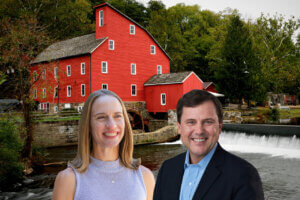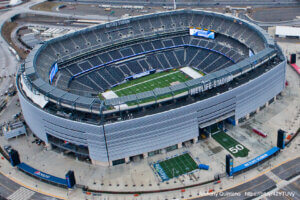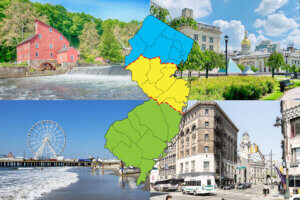PATRICK MURRAY: 732-263-5858 (office) | 732-979-6769 (cell) | pdmurray@monmouth.edu
KATHRYN KLOBY: 732-263-5892 (office) | kkloby@monmouth.edu
The use of websites by the public sector is gaining significant attention in recent years among practitioners and academics in the fields of public policy, public affairs, and communication. Websites have become one of the most important tools for citizens to get information about municipalities. A 2011 Monmouth University Poll showed that municipal websites are the first place New Jerseyans go for information about their hometowns. In fact, nearly 6-in-10 say they have looked up information about their town on the Internet – about the same number who say they have paid a visit to Town Hall. Moreover, Garden State residents are far more likely to visit a municipal website than to call or write a town official.
There is a growing appreciation of how municipal websites can be critical tools to inform the public, create efficiencies in the provision of public services, and engage residents. This trend is also recognized by the state of New Jersey which requires that certain information, such as town budgets, be available online. Websites are vehicles to increase public sector transparency, facilitate open government, and increase public trust in government. They can also streamline citizen interaction with local government and reduce the burden on municipal staff. Efforts to incorporate technology into public sector service delivery and interact with the public are referred to as E-Government.
The Monmouth University Polling Institute and the Monmouth University Graduate Program in Public Policy have conducted a project to evaluate municipal websites in New Jersey. The aim of this project is to assist the state’s municipalities in enhancing the effectiveness of their websites by identifying current best practices and trends in how New Jersey municipalities use their websites to inform citizens, provide services, and encourage public engagement.
Methodology
The team started by defining what constitutes appropriate website content. More than 100 discrete pieces of information and online activities were identified as being important for government website design. The final coding matrix included 86 items (see appendix). This determination was made by applying best practices in E-Government research and integrating examples from highly regarded community websites across the country, as well as items identified as important by New Jersey residents in a February 2011 Monmouth University/NJ Press Media Poll .
The appendix lists all items used in the project’s evaluation matrix with their associated weighted content scores. These discrete pieces of content can be grouped into four categories:
- Information for Citizens – basic information readily available to citizens, such as the names and contact information of elected officials and key personnel, meeting schedules and minutes, garbage pickup, permit and zoning information, and police, fire, and EMS contacts.
- Citizen Interaction – opportunities for citizens to engage in government by posting information about citizen advisory committees or professional positions, allowing direct email contact with key officials and staff, emergency alert sign-up, publication of bidding opportunities, and the provision of a website search function.
- Online Government Services – the ability to conduct online transactions for the convenience of citizens and more efficient public services, including the provision of downloadable forms, online applications (e.g., dog licensing), online payment for parking tickets, taxes, or dog licenses, and online public records requests (OPRA).
- Social Networking – while there remain many questions about best practices in how pubic agencies should harness the web to engage the public, many elected officials and administrators now use these tools to connect with constituents, including Twitter and/or Facebook, videos, photo sharing, and blogs.
The research team developed coding sheets [1] used to record the content on 540 municipal websites in New Jersey. [2] Each municipal website was assigned to three student coders who worked independently to record the presence or absence of each item. Researchers were instructed to look for the items on the code sheet across the entire website using direct links, scroll-down menus, and search boxes. Students exclusively used the town website to look for the information, i.e. students did not employ internet search engines unless provided within the municipal website itself. If at least two coders located an item, the website was assigned the corresponding weighted score for that item (see appendix). These weighted scores were added together to arrive at the final Content Score for each site.
Once all websites were coded for content, a team of three senior coders then assessed each municipal website for “ease of use” in finding four key pieces of information: mayor’s or mayor-equivalent’s contact information, building permit form or information, municipal budget, and trash/recycling information. The municipal budget is statutorily required to be available on municipal websites. Trash and recycling information was among the most requested pieces of information in the 2011 Monmouth University poll. If a municipality does not provide trash and/or recycling services, coders were instructed to look for information pertaining to how to arrange for these services (whether by private firm or the county).
To ascertain the Ease of Use Score, each coder recorded the amount of time it took from opening the municipal website homepage to locating the relevant information. Search times were capped at 120 seconds (2 minutes). The Ease of Use Score was obtained by averaging the search times of the three individual coders across all four items for each website.
Data collection for this project was conducted during 2012. Initial content scoring was done from March to June and ease of use evaluations were conducted from July to September. It should be noted that some municipalities have revised their websites since the study period and that the results in this report reflect the status of New Jersey’s municipal websites as of the fall of 2012.
The final Content Score was determined by adding the individual weights of each successfully located item. Broken down by category, basic information items contributed approximately 40% to the Content Score, citizen interaction items contributed 31%, online services 18%, and social networking 11%. The potential maximum score for content was 78.8. In actuality, the Content Scores for the 540 evaluated websites ranged from 5.8 to 60.3.
The final Ease of Use Score was determined by inverting the tracked timings and reducing the average to a potential scale from 0 to 60, with higher scores reflecting websites that are easier to use. The actual range of Ease of Use Scores for the 540 New Jersey municipal websites in this project was 6.0 to 55.8.
The final score for each town was arrived at by doubling the Content Score and adding it to the Ease of Use Score. As such, content accounted for approximately two-thirds of the final score and ease of use for one-third. These combined evaluation scores ranged from 26.5 to 172.9 for the 540 municipal websites analyzed in this study.
Findings
Nearly 6-in-10 New Jersey municipal websites provide at least half of the content items covered in this evaluation. This includes 244 sites that provide between one-half and two-thirds of the evaluated items and 72 that provide between two-thirds and four-fifths of the items. Another 166 included between one-third and one-half of the items and 58 included fewer than one-third. No municipal website contain more than four-fifths of the content items in the project’s evaluation matrix. The most content-heavy sites in the evaluation contain 68 of the 86 listed items – or 79% of potential content items.
Nearly all websites include the following information: the names of council members (98%), mayor (97%), and town clerk (94%), as well as the municipal hall address (96%). About two-thirds of town websites provide an email link or message function to directly reach the clerk (66%), mayor (61%), or council members (58%). Just under half provide department emails (48%). However, if a constituent does not know which department should be contacted, only 20% of websites provide a general email address to reach town hall.
It is worth noting that the coding team could not clearly locate the municipal budget on 15% of the websites. This does not necessarily mean that the budgets were not available online, but that our coders could not locate them. Municipalities are required by New Jersey statute to post budgets on their websites. Furthermore, a number of websites did not provide the most recent municipal budget, although it is not possible to determine the exact number of out-of-date budgets because some municipalities were still planning their fiscal years while the study was in process. [Note: Complete results for the percentage of websites providing each content item can be found in the appendix.]
The amount of content available on a municipal website correlates significantly to the size of the town. In other words, the larger the town, the more content the website is likely to provide. This finding includes all types of items, from basic information to interactive content. For instance, about three-quarters (74%) of websites for municipalities with populations of 10,000 or more include at least half of the 86 content items used in the evaluation. That declines to 64% among towns with populations between 5,000 and 10,000. There is a significant drop off to 38% of towns with populations between 2,500 and 5,000 who have at least half of the evaluated items on their websites, and a further drop to just 23% of towns with fewer than 2,500 people. [3]
| WEBSITE PERFORMANCE BY MUNICIPAL POPULATION | ||
| Population |
Content Score |
Ease of Use Score |
| All municipalities |
33.5 |
39.6 |
| Under 2,500 |
24.5 |
36.6 |
| 2,500 to 4,999 |
28.3 |
37.8 |
| 5,000 to 9,999 |
33.6 |
40.6 |
| 10,000 to 24,999 |
37.3 |
41.4 |
| 25,000 or more |
39.8 |
39.9 |
The table above presents the average evaluation scores for both content and ease of use by different categories of municipal population. Among the smallest towns with fewer than 2,500 residents, the average Content Score is 24.5. This increases steadily to top out at an average Content Score of 39.8 among municipalities with 25,000 or more residents.
There is no clear relationship, however, for the ease of use component of the study. The Ease of Use score does appear to improve slightly among towns with larger populations, although it drops off at the top category of 25,000 residents or more.
These relationships can also be viewed as correlation coefficients presented in the table below. Among a variety of municipal factors examined, population size shows the strongest correlation with the amount of content available on a municipal website, including both basic information and interactive items. The correlation between population size and ease of use, though, is not significant.
| WEBSITE SCORE CORRELATIONS | |||||
|
Ease of Use |
Total Content |
Citizen Interaction |
Online Services |
Social Media | |
| Population size |
-.033 |
.250** |
.200** |
.214** |
.162** |
| Municipal budget |
-.075 |
.125** |
.087 |
.182** |
.051 |
| Spending per capita |
.124** |
-.093* |
-.102* |
.088 |
-.065 |
| Average home value |
.039 |
-.018 |
-.021 |
.015 |
-.014 |
| Average property tax bill |
.125** |
.224** |
.205** |
.089* |
.114** |
* p<.05, ** p<.01
The size of local property tax bills also correlates with the amount of content likely to be available on a municipality’s website. This appears to imply that towns with higher tax bills provide more robust websites (keeping in mind that less than half of the typical property tax bill actually goes to municipal services). However, another factor – per capita municipal spending – suggests that the relationship may actually be negative. The correlations suggest that higher levels of municipal spending per resident translates to less content available on the town’s website, although this relationship is relatively weak.
In actuality, there seems to be a bell-shaped relationship between per capita spending and website content. Specifically, for towns that spend between $750 and $2,000 per resident the average Content Score ranges along a narrow band from 35.0 to 35.7. This score is lower for towns at either end of the per capita spending continuum, including those that spend over $2,000 per resident (32.5) or less than $750 per resident (31.3).
There is a small but significant correlation, though, between per capita spending and how easy it is to find information on a municipal website. The average Ease of Use Score starts at 36.8 among towns that spend less than $750 per resident and increases steadily to 41.9 among those that spend over $2,000 per resident. [4]
| WEBSITE PERFORMANCE BY MUNICIPAL SPENDING | ||
| Municipal budget per capita |
Content Score |
Ease of Use Score |
| All municipalities |
33.5 |
39.6 |
| Less than $750 |
31.3 |
36.8 |
| $750 to $999 |
35.1 |
39.2 |
| $1,000 to $1,249 |
35.0 |
40.7 |
| $1,250 to $1,499 |
35.7 |
41.7 |
| $1,500 to $1,999 |
35.5 |
41.4 |
| $2,000 or more |
32.5 |
41.9 |
The project also examined how the source or provider of website design services impacts site performance. Project coders tentatively identified the design providers for 376 municipal websites based on information provided on each website. Approximately 23% appear to have been designed by municipal staff, 33% were designed by either a volunteer or a vendor who provided that service to a single municipality, and 44% were designed by vendors who provide design services to multiple municipalities.
| WEBSITE PERFORMANCE BY DESIGNER | ||
| Website designer |
Content Score |
Ease of Use Score |
| All websites |
33.5 |
39.6 |
| Municipality designed |
33.9 |
37.5 |
| Third party designer with multiple clients |
37.6 |
41.4 |
| Third party designer with single client |
30.9 |
38.5 |
| Unknown |
31.1 |
39.8 |
Websites that are designed by third party vendors with multiple clients tend to perform better than those which are designed by single-client designers or by municipal staff. The average Content Score for multiple-client vendor sites is 37.6 compared to 31.1 for other third party designers and 33.9 for municipal staff designed sites. The Ease of Use Score is also higher for multiple client vendor sites (41.4) than it is for other third-party designers (38.5) and municipal staff designed sites (37.5).
The Ease of Use Score for all websites was based on the average time it took to find four key pieces of information on each website. Overall, finding permit information took an average of 31 seconds to locate. Information about the mayor and the municipal budget each took about 35 seconds to find. Information about trash pick-up took the longest, 61 seconds on average.
| AVERAGE TIME TO FIND CONTENT BY DESIGNER | ||||
| (in seconds) |
Mayor |
Permit |
Budget |
Trash |
| All websites |
35.1 |
31.3 |
34.5 |
60.8 |
| Municipality designed |
37.3 |
39.1 |
38.4 |
64.8 |
| Third party designer with multiple clients |
32.0 |
27.0 |
28.5 |
60.7 |
| Third party designer with single client |
37.7 |
30.1 |
41.9 |
59.8 |
| Unknown |
35.1 |
32.3 |
32.7 |
59.6 |
The average time it took to find the mayor’s contact information on multiple-client vendor designed sites was 32.0 seconds, which is about five seconds faster than for either other third party designed sites or municipal staff designed sites. Permit information took about 27.0 seconds to find on multiple-client vendor designed sites, about three seconds faster than for other third party designed sites and 12 seconds faster than for municipal staff designed sites.
Finding the municipal budget took an average of 28.5 seconds to locate on multiple-client vendor designed sites, about 13 seconds faster than for other third party designed sites and 10 seconds faster than for municipal staff designed sites. Finding trash pick-up information took the longest and showed the smallest differences by design – 60.7 seconds for multiple-client vendor designed sites, which was actually one second longer than other vendor designed sites and 4 seconds faster than municipal staff designed sites.
Projects coders also noted that half (50%) of all municipal websites contained at least one broken link. Multiple-client vendor sites were the least likely to have broken links (43%) when compared to other third party designed sites (50%) or municipal staff designed sites (63%).
Evidence from this project suggests that vendors who serve multiple clients produce the best performing websites. This should not be construed, though, as suggesting that engaging such a vendor ensures an optimal municipal website. Websites created by the most frequently used vendors – such as QScend, GovOffice, and Cit-e-Net – attain above average scores for both content and ease of use. However, websites using these vendors also showed a wide range of scores in this evaluation. Some smaller vendors, such as Virtual Town Pages and CivicPlus, have fewer websites to their credit, but scores for those websites consistently cluster in the upper tiers of the evaluation results.
2013 New Jersey E-Government Awards
In an effort to encourage best practices among all municipal websites in New Jersey, the project recognizes municipalities whose scores reflect particularly effective website utility. [Note: The complete list of municipal rankings and scores is appended to this report.]
Municipal websites that provide the best combination of content availability and ease of use are:
| NEW JERSEY’S TEN BEST MUNICIPAL WEBSITES | |||
|
OVERALL RANK | COUNTY | MUNICIPALITY | WEBSITE URL |
|
1 | Monmouth | Middletown Township | http://www.middletownnj.org/ |
|
2 | Bergen | Franklin Lakes Borough | http://www.franklinlakes.org/ |
|
3 | Mercer | West Windsor Township | http://www.westwindsornj.org/ |
|
4 | Mercer | Princeton Township* | http://www.princetontwp.org/ |
|
5 | Mercer | Robbinsville Township | http://www.robbinsville-twp.org/ |
|
6 | Morris | Randolph Township | http://www.randolphnj.org/ |
|
7 | Middlesex | North Brunswick Township | http://www.northbrunswicknj.gov/ |
|
8 | Mercer | Lawrence Township | http://lawrencetwp.com/ |
|
9 | Middlesex | Old Bridge Township | http://www.oldbridge.com/ |
|
10 | Bergen | Fort Lee Borough | http://www.fortleenj.org/ |
| HONORABLE MENTION | |||
|
OVERALL RANK | COUNTY | MUNICIPALITY | WEBSITE URL |
|
11 | Middlesex | South Brunswick Township | http://www.twp.south-brunswick.nj.us/ |
|
12 | Bergen | Englewood City | http://cityofenglewood.org/ |
|
13 | Morris | Washington Township | http://www.washtwpmorris.org/ |
|
14 | Morris | Mendham Township | http://www.mendhamtownship.org/ |
|
15 | Camden | Cherry Hill Township | http://www.cherryhill-nj.com/ |
|
16 | Morris | Roxbury Township | http://www.roxburynj.us/ |
|
17 | Middlesex | Sayreville Borough | http://www.sayreville.com/ |
|
18 | Bergen | Glen Rock Borough | http://www.glenrocknj.net/ |
|
19 | Essex | Montclair Township | http://www.montclairnjusa.org/ |
|
20 | Bergen | Bergenfield Borough | http://www.bergenfieldboro.com/ |
|
21 | Gloucester | Woodbury City | http://www.woodbury.nj.us/ |
|
22 | Monmouth | Red Bank Borough | http://www.redbanknj.org/ |
|
23 | Essex | Livingston Township | http://www.livingstonnj.org/ |
|
24 | Gloucester | Woodbury Heights Borough | http://www.bwhnj.com/ |
|
25 | Camden | Magnolia Borough | http://www.magnolia-nj.org/ |
* Note: study was conducted before the Princeton municipal merger.
In addition to the overall best-rated websites, the following municipalities are recognized for their performance in specific areas:
| BEST WEBSITES FOR EASE OF USE [Note: Must be among top 1/5 th overall to qualify.] | |||
|
OVERALL RANK | COUNTY | MUNICIPALITY | WEBSITE URL |
|
18 | Bergen | Glen Rock Borough | http://www.glenrocknj.net/ |
|
89 | Monmouth | Manasquan Borough | http://www.manasquan-nj.com/ |
|
105 | Monmouth | West Long Branch Borough | http://www.westlongbranch.org/ |
|
58 | Bergen | Dumont Borough | http://www.dumontnj.gov/ |
|
63 | Bergen | Oradell Borough | http://www.oradell.org/ |
|
7 | Middlesex | North Brunswick Township | http://www.northbrunswicknj.gov/ |
|
64 | Bergen | Demarest Borough | http://www.demarestnj.us/ |
|
1 | Monmouth | Middletown Township | http://www.middletownnj.org/ |
|
25 | Camden | Magnolia Borough | http://www.magnolia-nj.org/ |
|
36 | Camden | Lindenwold Borough | http://www.lindenwoldnj.gov/ |
|
42 | Burlington | Bordentown Township | http://www.bordentowntownship.com/ |
| BEST WEBSITES FOR CITIZEN INTERACTION
[Note: Must be among top 1/5 th overall to qualify.] | |||
|
OVERALL RANK | COUNTY | MUNICIPALITY | WEBSITE URL |
|
15 | Camden | Cherry Hill Township | http://www.cherryhill-nj.com/ |
|
76 | Bergen | Emerson Borough | http://www.emersonnj.org/ |
|
1 | Monmouth | Middletown Township | http://www.middletownnj.org/ |
|
8 | Mercer | Lawrence Township | http://lawrencetwp.com/ |
|
32 | Mercer | Trenton City | http://www.trentonnj.org/ |
|
3 | Mercer | West Windsor Township | http://www.westwindsornj.org/ |
|
6 | Morris | Randolph Township | http://www.randolphnj.org/ |
|
2 | Bergen | Franklin Lakes Borough | http://www.franklinlakes.org/ |
|
30 | Essex | Fairfield Township | http://www.fairfieldnj.org/ |
|
54 | Camden | Winslow Township | http://www.winslowtownship.com/ |
| HONORABLE MENTION FOR OVERALL CONTENT
[Note: Must be among top 1/5 th overall to qualify.] | |||
|
OVERALL RANK | COUNTY | MUNICIPALITY | WEBSITE URL |
|
32 | Mercer | Trenton City | http://www.trentonnj.org/ |
|
34 | Atlantic | Egg Harbor Township | http://www.ehtgov.org/ |
|
27 | Bergen | Washington Township | http://www.twpofwashington.us/ |
|
33 | Gloucester | Washington Township | http://www.townshipnj.com/ |
|
44 | Middlesex | Metuchen Borough | http://www.metuchennj.org/ |
|
53 | Burlington | Mount Holly Township | http://www.mountholly.info/ |
|
51 | Gloucester | Monroe Township | http://monroetownshipnj.org/ |
Acknowledgements
This project was designed and conducted by the research team of Patrick Murray, Director of the Monmouth University Polling Institute, Dr. Kathryn Kloby, Director of the Monmouth University Graduate Program in Public Policy, and Dr. Thomas Lamatsch, Assistant Professor of Political Science and Monmouth University Polling Institute Fellow. The project manager was Frank Guagenti. The senior coders were Tim Tracey, David Goldenthal and D.J. McCarthy. Content coders included Daniel Zagury, Britney Wade, Cara Turcich, Cassandra Rosner, Kelsey Rinear, Sheila Patoka, Vishruti Desai, Shayna Conde, Cassi Capparelli, Meredith Cahill, and Laura Buhler.
[Note 1] The initial coding sheet and content weighting system was designed and tested in a 2011 pilot study using Monmouth County municipal websites. In the current statewide project, interactive content items have been given more weight than in the pilot.
[Note 2] Only websites where it was reasonably apparent that the municipality authorized the website were included in the analysis. Towns without a website or where the website appeared to be a volunteer effort were excluded (n=26).
[Note 3] It is worth noting that barely more than 4-in-10 of New Jersey’s 565 incorporated municipalities have at least 10,000 residents, while one-third have fewer than 5,000 residents.
[Note 4] Towns at the top end of the per capita spending range include a heavy representation of shore communities, while those at the lower end of municipal spending per capita tend to be mostly less affluent small towns.




